- News
- Reviews
- Bikes
- Components
- Bar tape & grips
- Bottom brackets
- Brake & gear cables
- Brake & STI levers
- Brake pads & spares
- Brakes
- Cassettes & freewheels
- Chains
- Chainsets & chainrings
- Derailleurs - front
- Derailleurs - rear
- Forks
- Gear levers & shifters
- Groupsets
- Handlebars & extensions
- Headsets
- Hubs
- Inner tubes
- Pedals
- Quick releases & skewers
- Saddles
- Seatposts
- Stems
- Wheels
- Tyres
- Tubeless valves
- Accessories
- Accessories - misc
- Computer mounts
- Bags
- Bar ends
- Bike bags & cases
- Bottle cages
- Bottles
- Cameras
- Car racks
- Child seats
- Computers
- Glasses
- GPS units
- Helmets
- Lights - front
- Lights - rear
- Lights - sets
- Locks
- Mirrors
- Mudguards
- Racks
- Pumps & CO2 inflators
- Puncture kits
- Reflectives
- Smart watches
- Stands and racks
- Trailers
- Clothing
- Health, fitness and nutrition
- Tools and workshop
- Miscellaneous
- Buyers Guides
- Features
- Forum
- Recommends
- Podcast
TECH NEWS
 Trek Madone 9 Series Project One (1)
Trek Madone 9 Series Project One (1)Trek reveals 2016 range: New models and loads of lower prices
Trek has introduced new models and lowered many prices of existing bikes for 2016. We visited the brand yesterday to check them all out, so let’s go through some of the key categories.
Emonda
When it comes to performance road bikes, Trek offers three different categories. Madone bikes are aimed at riders wanting aerodynamic efficiency; Domane bikes are for those who prioritise a smooth ride; Emondas are for people who want light weight.
Trek has introduced a new model in the Emonda ALR aluminium series. The Emonda ALR 4 (not pictured) is built around the same 1,050g 300 Series Alpha Aluminium frame as the existing bikes, and it has the same super-smooth welds, but it's specced with the new Shimano Tiagra groupset. It is available in either black or red and takes over as the most affordable Emonda you can buy, priced at £900.
.jpg)
The Shimano 105-equipped ALR 5 (above) comes down in price from £1,300 to £1,100 while the ALR 6 that we reviewed recently is now £1,400 rather than £1,700. This model (head tube welds pictured below), which comes in a Shimano Ultegra build, is outstanding value for money.
.jpg)
Trek has reduced loads more prices across the Emonda range. We won’t go through the lot but the Emonda S 5 looks very good value after a price cut from £1,500 to £1,300.
.jpg)
The S series Emondas have carbon-fibre frames and forks, the S 5 (above) being built up with a full Shimano 105 groupset.
The SL series Emondas are made from a higher grade of carbon and have a seatmast rather than the standard seatpost design of the S bikes. The popular 105-equipped SL 5 is now £1,800 rather than £1,900, and the SL 6 – which is built up with a full Shimano Ultegra groupset – drops from £2,300 to £2,100. This one is now available in a Tour de France leader-style yellow finish, as well as in black.
The SL 8 (above), available in either a SRAM Red or a Shimano Dura-Ace build, weighs in below the UCI’s 6.8kg minimum weight limit for racing. The price has dropped from £3,100 to £2,900.
The lightest of all the Emondas are the SLRs, made from a higher grade of carbon again. Trek gives the frame weight as just 690g. The SLR also has direct mount brakes and the full carbon fork comes with an asymmetric steerer that’s designed to flex a touch to provide more comfort and control over rough surfaces.
.jpg)
The SLR 6 (above), specced with a Shimano Ultegra groupset, stays at £4,300 but it now comes in this red smoke finish or in a matt powder blue.
.jpg)
There’s noticeably more colour in the Trek this year, which is good news for those who have had enough of black.
.jpg)
All of the Emonda SLRs are available in that powder blue. This (above and below) is the SLR 9 which has a mechanical Dura-Ace groupset, Bontrager's excellent Aeolus 3 wheels, and a price tag of £8,000. Ouch!
.jpg)
Domane
Trek launched the Domane over three years ago – doesn't time fly? – its main USP being its Isospeed Decoupler, technology that allows the seat tube to move independently of the rest of the frame in order to provide more comfort and control.
Go to our story from the launch for a refresher on how it works.
The technology has now been extended to the Madone.
Every Domane has an IsoSpeed fork that’s designed to provide more fore/aft movement up front for a smoother ride, and they’re all built to Trek’s endurance geometry – a fairly upright ride position for comfort and a long wheelbase for stability.
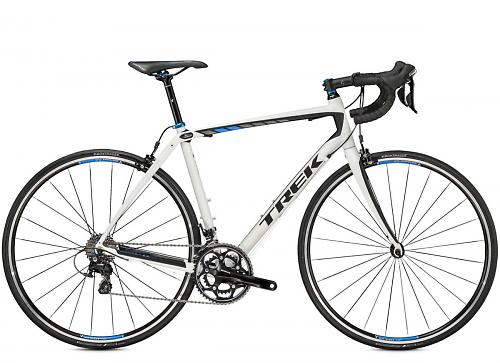
Most of the changes in the Domane range for 2016 are to colours and prices. The cheapest Domane, the aluminium 2.0, remains at £900 but it’ll now come in Trek Factory Racing livery (similar to the Emonda ALR 5, above) while the existing 2.3 (above), built up with a Shimano 105 groupset, drops from £1,100 to £1,000.
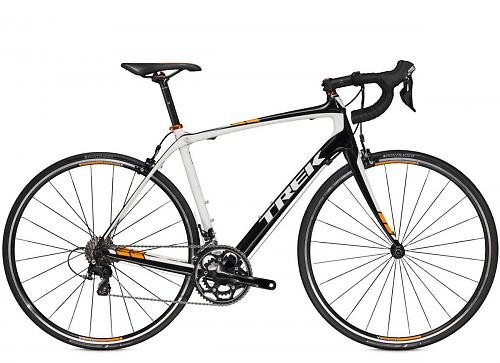
The 4 Series Domanes are built around carbon frames and the existing 4.3 (above), specced with Shimano 105, looks great value after a price reduction to £1,500.
The disc version switches from TRP Hy/Rd cable operated hydraulic brakes to Shimano RS505 hydraulic brakes. This one will be £1,900 when it arrives in the UK in November.
Unlike the 4 Series bikes, the 5 Series Domanes have seatmasts rather than standard seatposts, and internal cable routing. They're also made from a higher grade of carbon fibre. The 5.2 (above), with a Shimano Ultegra groupset and Bontrager Race Tubeless Ready wheels, is £2,200. As well as a safe white version, it comes in a brown bear/Waterloo blue option.
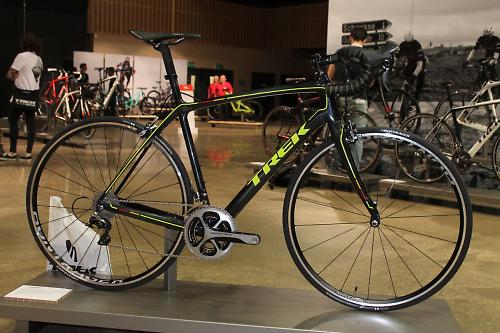
The 6.5 (above, £3,900) is a new addition to the Domane range, coming with a Shimano Dura-Ace mechanical groupset and Bontrager’s new Paradigm Elite tubless ready wheels. Like all the other Domanes, it comes with hidden mudguard mounts.
Madone
We’ve already shown you the new 9 Series Madone so check out our previous story for all the details on that one. We'll have a review on road.cc soon.
.jpg)
Here are just a couple of additional pics. This one is a Project One model in a bespoke finish. We think it looks pretty neat.
.jpg)
And this is a frame with a cutaway outer seat tube that allows you to see the inner seat tube (red) that’s free to flex and add comfort to the ride.
Lexa
The women’s market has grown massively for Trek with a 14% increase in sales of its WSD (Women’s Specific Design) models over the past year. Trek also believes there has been an increase in the number of women buying smaller sized standard geometry bikes.
.jpg)
The aluminium Lexa S (£650), equipped with a Shimano Sora 9-speed drivetrain, remains at £650 but it’s now available in this Miami Green Pearl finish (above).
.jpg)
The Lexa SL (above) stays at £750 but it gets the new Shimano Tiagra groupset.
The Lexa SLX (not pictured) is a very different bike in that it’s made from a higher grade of aluminium and features an IsoSpeed Decoupler to add comfort (see above). A tapered head tube and oversized BB86.5 bottom bracket are designed to add stiffness. Built up with Shimano 105 kit, it’s price has now come down to £1,000. That looks like a steal to us.
Silque
The Silque bikes use the same IsoSpeed Decoupler as the Domane, but they’re built to a WSD geometry.
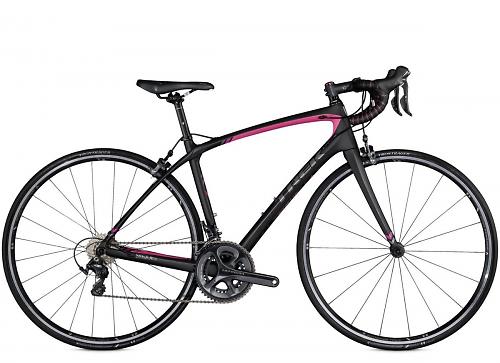
The Silque SL (above), in an existing colour that carries through, has a 400 Series OCLV Carbon frame with a tapered head tube and an oversized bottom bracket – both key features of performance frames these days – along with hidden mudguard mounts for added practicality. Your £2,200 gets you a Shimano Ultegra mechanical build.
The same bike is now available in a new Ultegra Di2 version for £3,000.
The Silque SSL (above) has come way down in price to £3,800. Trek have downgraded the wheels from Bontrager Race X Lites to Bontrager Lites, but you’re still getting much better value now.
Cyclocross
Trek is dropping many prices on its Boone and Crockett cyclocross bikes too. The existing top-end Boone 9 Disc, for example, was £3,700 but it’s now £3,200.
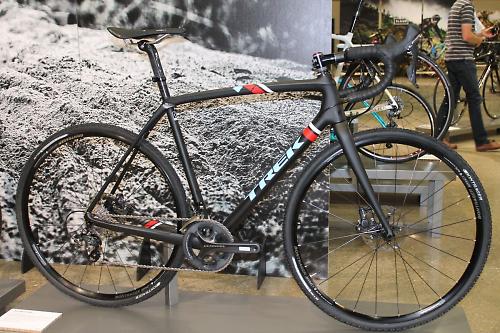
That’s a bike with a 600 Series OCLV carbon frame, Isospeed Decoupler, and a Shimano Ultegra groupset with RS685 hydraulic disc brakes.
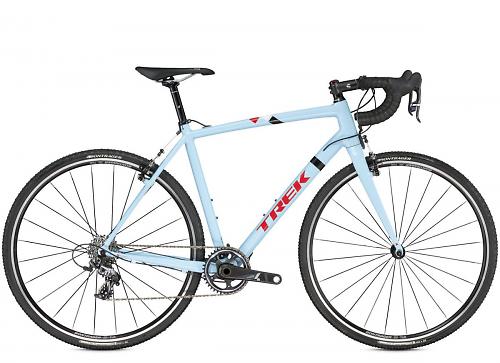
The aluminium Crockett 7 that was £1,800 is now £1,600.
Mat has been in cycling media since 1996, on titles including BikeRadar, Total Bike, Total Mountain Bike, What Mountain Bike and Mountain Biking UK, and he has been editor of 220 Triathlon and Cycling Plus. Mat has been road.cc technical editor for over a decade, testing bikes, fettling the latest kit, and trying out the most up-to-the-minute clothing. He has won his category in Ironman UK 70.3 and finished on the podium in both marathons he has run. Mat is a Cambridge graduate who did a post-grad in magazine journalism, and he is a winner of the Cycling Media Award for Specialist Online Writer. Now over 50, he's riding road and gravel bikes most days for fun and fitness rather than training for competitions.
Latest Comments
- No Reply 1 hour 47 min ago
Nothing new. Cyclists are public enemy number 1. I was minding my own business yesterday on a very narrow single track lane with passing places. As...
- Hirsute 3 hours 14 min ago
Anyone vomiting whilst driving could have a detrimental effect on others....
- IanGlasgow 4 hours 17 min ago
Indicators for bikes are still with us. The best/least bad I've tried are:...
- IanGlasgow 4 hours 22 min ago
Indicators for bikes are still with us. The best/least bad I've tried are:...
- Terry Hutt 6 hours 16 min ago
I was interested in the EasiCyco backpack until I watched their Kickstarter video. Both their riders' bums rub on the backpack. That's a hard NO...
- redhanded 8 hours 45 min ago
I had 2 bikes stolen from bike shed outside my flat in London last year. They ended up for sale in Russia. A cycling club I'm a member of tweeted...
- Deac 9 hours 46 min ago
I tried the footrest on the way home, it's a great idea, you can keep on the saddle making it easier to get away from the traffic lights, and being...
- ktache 12 hours 40 min ago
Not that they would be as technical, or maybe quite as grippy, but does the skate industry provide any solutions?
- Rendel Harris 13 hours 22 min ago
Sorry to be a killjoy but it doesn't amuse me at all, I hope the idiot gets caught and punished. Putting yourself on the same road as pros...
- willpom @GWRaudax 13 hours 57 min ago
Steve Poulton has just published The Cheltenham Flyer - 10th May https://www.audax.uk/event-details/calendar/13235-cheltenham_new_flyer_200
Add new comment
20 comments
I can't understand why anyone would want people to think they are riding a Bianchi, proper mid-life crisis bike...
Perhaps the fact that Bianchi having been using celeste for 125 years makes people feel that Trek are copying them.
It seems to me the SL is no lighter than an awful lot of other frames(Canyon, Rose in particular give a lighter overall build) so why is it more likely to break?
The new Madone is a thing of beauty. I looked at the Crockett and Boone as a commuter, but the cost is just a bit too much for their entry carbon frame and I could not see enough special about the aluminium to go for it.
Hope some of the top end Madone flows to through to the mid-range. My 2009 needs an update.
Hey Colin, have you considered a Crossrip for commuting purposes? Or is it a carbon commuter that you are after specifically? If so, a 4 Series Domane would be a great option. It's also available in both disc and non-disc versions, and has eyelets for installing mudguards.
I've never been a fan of Trek bikes, but I like the look of the new Madone.
With the new Madone effectively decoupling the seatpost, is there any further need for the Domane??
Hey stealth, great question.
While the function of the IsoSpeed is essentially the same in both bikes, there is a significant difference in how much compliance is offered between the models.
Even with the IsoSpeed, Madone is not meant to be as compliant as Domane. Madone IsoSpeed performs the same task of minimising 'white noise' from the road, but it's compliance is slightly more than that of the Émonda. It's main purpose is to make an aero bike comfortable, which as most know, has been lacking in aero bikes to date.
That being said, anyone who rides one will notice less transfer of road vibration as a result of the IsoSpeed, but what will be the standout feature is that a bike designed to maximise it's aero profile is comfortable to ride.
That 9-series Madone looks nice.
I forgot that Bianchi had copyright of turquoise.
Why oh why do they persist in painting bikes in that colour and pretending its a Bianchi?
All the gear, no idea?
Leopard Blue > Celeste.
Less common too.
It looks nothing like Bianchi's colour...
Hi qwerky, not sure which bikes you're referring to, but we have no celeste coloured bikes in the range. If you mean the blue bikes, then this is the actual colour: http://www.trekbikes.com/uk/en/bikes/mountain/cross_country/top_fuel/
The website will be updated later this week with all of the new colours.
Emondas break easily in crashes. I know of several that have.
Dealers must love them.
If you want something crash resistant buying one of the lightest production frames available probably isn't the most sensible option - you can squeeze the top tube between your fingers and see it give. In this respect anyone complaining about one braking in a crash is being a bit naive.
I'd like to see across-brand common standards measuring robustness of Carbon Bikes. Lacking that, one could assume that heavier carbon bikes might be more robust, but no brand would point out their frame is heavier. As it is, the market seems to focus only on less weight, which inevitably results in flimsy bikes and is especially problematic for riders over 150 kg.
Sure, any bike that's designed to be light has the potential to get damaged in a crash. However, it could be argued that any bike will break easily given the right conditions in a crash. These frames are rigorously tested in our labs, and then under Trek Factory Racing.
Anyone riding them should feel confident that they aren't getting something that is frail.
A vast range... none of which tug at the heart strings.. uninspired.
Sorry to hear that, shadwell. Have you had a chance to ride any of them? That might be all the tugging you need.